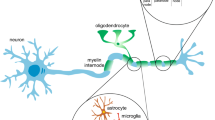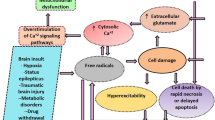Summary
Several primary and secondary reactions were observed in rat hippocampus at various times following low doses of intraventricular kainic acid. The well documented fulminating lesion of subfield CA3a was evident, however, with the parameters of the present study, the acute neuronal death was restricted to areas which have been shown by others to have an exceptionally dense mossy fiber input. Neurons in subfields CA3c and CA4 also die, however, this was apparent only after a survival time of 2 weeks; prior to this, these cells went through a period of chromatolysis and dendritic swelling. In remaining subfields, principally ‘CA2’ and CA1, a third type of change was observed at longer intervals of 1 month. This was characterized by neuronal skrinkage and chromophilia and eventual cell loss. The present study provides additional observations on the actions of kainic acid in the hippocampus and may be relevant to the dynamic pathology of temporal lobe epilepsy.
Similar content being viewed by others
References
Ben-Ari Y, Lagowska J, Tremblay E, Le Gal La Salle H (1979a) A new model of focal status epilepticus: intra-amygdaloid application of kainic acid elicits repetitive secondary generalized convulsive seizures. Brain Res 163:176–179
Ben-Ari Y, Tremblay E, Ottersen OP (1980a) Injections of kainic acid into the amygdaloid complex of the rat: an electrographic, clinical and histological study in relation to the pathology of epilepsy. Neuroscience 5:515–528
Ben-Ari Y, Tremblay E, Ottersen OP, Meldrum BS (1980b) The role of epileptic activity in hippocampal and ‘remote’ cerebral lesions induced by kainic acid. Brain Res 191:79–97
Ben-Ari Y, Tremblay E, Ottersen OP, Naquet R (1979b) Evidence suggesting secondary epileptogenic lesions after kainic acid: pretreatment with diazepam reduces distant but not local damage. Brain Res 165:362–365
Ben-Ari Y, Tremblay E, Riche D, Ghilini G, Naquet R (1981) Electrographic, clinical and pathological alterations following systemic administration of kainic acid, bicuculline or pentetrazole: metabolic mapping using the deoxyglucose method with special reference to the pathology of epilepsy. Neuroscience 6: 1361–1391
Brown AW, Levy DE, Kublik M, Harrow J, Plum F, Brierley JB (1979) Selective chromatolysis of neurons in the gerbil brain: a possible consequence of “epileptic” activity produced by common carotid artery occlusion. Ann Neurol 5:127–138
Brown WJ (1973) Structural substrates of seizure foci in the human temporal lobe. In: Brazier M (ed) Epilepsy: Its phenomena in man. Academic Press, New York, pp 339–372
Cammermeyer J (1972) Nonspecific changes of the central nervous system. In: Bourne G (ed) Structure and function of nervous tissue, vol VI. Academic Press, New York, pp 167–179
Carlsen J, de Olmos J (1981) A modified cupric-silver technique for the impregnation of degenerating neurons and their processes. Brain Res 208:426–431
Cavalheiro BA, Riche DA, Le Gal La Salle G (1982) Long-term effects of intrahippocampal kainic acid injection in rats: A method for inducing spontaneous recurrent seizures. Electroenceph Clin Neurophysiol 53:581–589
Corsellis JAN (1955) The incidence of Ammon's horn sclerosis. Brain 80:193–208
Cotman CW, Nadler JV (1978) Renctive synaptogenesis in the hippocampus. In: Cotman C (ed) Neuronal plasticity. Raven Press, New York, pp 227–271
Coyle JT, Slevin J, London ED, Biziere K, Collins J (1980) Characterization of neuronal recognition sites for (3H) kainic acid. In: Olsen R, Yammamura W, Usdin E (eds) Psychopharmacology and biochemistry of neurotransmitter receptors. Raven Press, New York, pp 501–513
Coyle JT, Zaczek R, Sleven J, Collins J (1981) Neuronal receptor sites for kainate and correlations with neurotoxicity. In: Di Chiara G, Gessa G (eds) Glutamate as a neurotransmitter. Raven Press, New York, pp 337–346
del Cerro M, Cogen J, del Cerro C (1980a) Stevenel's blue, an excellent stain for optical microscopical study of plastic embedded tissues. Microsc Acta 83:117–121
del Cerro M, Standler NS, del Cerro C (1980b) High resolution optical microscopy of animal tissue by the use of sub-micrometer thick sections and a new stain. Microsc Acta 83:217–220
Desclin J, Escubi J (1975) An additional silver impregnation method for demonstration of degenerating nerve cells and processes in the central nervous system. Brain Res 93:25–39
Falconer M (1968) The significance of mesial temporal (Ammon's horn) sclerosis in epilepsy. Guys Hosp Rep 117:1–12
Falconer M (1974) Mesial temporal (Ammon's horn) sclerosis as a common cause of epilepsy. Lancet 2:767–770
Foster AC, Mena EE, Monaghan DT, Cotman CW (1981) Synaptic localization of kainic acid binding sites. Nature 289:73–75
Franck JE (1981) The effect of kainic acid, bicuculine or neonatal febrile convulsions on hippocampal morphology. Unpublished doctoral dissertation submitted to the University of Rochester
Grant G (1970) Neuronal changes central to the site of axon transection. A method for the identification of retrograde changes in perikarya, dendrites and axons by silver impregnation. In: Nauta W, Ebbesson S (eds) Contemporary research methods in neuroanatomy. Springer, Berlin Heidelberg New York, pp 173–185
Hjorth-Simonsen A (1970) Fink-Heimer silver impregnation of degenerating axons and terminals in mounted cryostat sections of fresh and fixed brains. Stain Tech 45:199–204
Konigsmark BW (1970) Methods for the counting of neurons. In: Nauta W, Ebbesson S (eds) Contemporary research methods in neuroanatomy. Springer, Berlin Heidelberg New York, pp 315–340
Lorente de No R (1934) Studies on the structure of the cerebral cortex. II. Continuation of the study of the ammonic system. J Psych Neurol 46:113–177
Lothman EW Collins RC (1981) Kainic acid induced limbic seizures: metabolic, behavioral, electroencephalographic and neuropathological correlates. Brain Res 218:299–318
Lothman EW, Collins RC, Ferrendelli JA (1981) Kainic acid-induced limbic seizures: electrophysiologic studies. Neurology 31:806–812
Morrell F (1964) Modification of RNA as a result of neural activity. In: Brazier M (ed) Brain function II: RNA and brain function, memory and learning. University of California Press, Los Angeles, pp 183–202
Morrell F (1969) Physiology and histochemistry of the mirror focus. In: Jasper H, Ward A, Pope A (eds) Basic mechanisms of the epilepsies. Little, Brown & Co, Boston, MA, pp 357–369
Nadler JV (1981) Role of excitatory pathways in the hippocampal damage produced by kainic acid. In: Di Chiara G, Gessa G (eds) Glutamate as a neurotransmitter. Raven Press, New York, pp 395–402
Nadler JV, Cuthbertson GJ (1980) Kainic acid neurotoxicity toward hippocampal formation: dependence on specific excitatory pathways. Brain Res 195:47–56
Nadler JV, Perry BW, Cotman CW (1978) Preferential vulnerability of hippocampus to intraventricular kainic acid. In: McGeer E, Olney J, McGeer P (eds) Kainic acid as a tool in neurobiology. Raven Press, New York, pp 219–238
Nadler JV, Perry BW, Cotman CW (1980a) Selective reinnervation of hippocampal area CA1 and the fascia dentata after destruction of CA3–CA4 afferents with kainic acid. Brain Res 182:1–9
Nadler JV, Perry BW, Gentry C, Cotman CW (1980b) Degeneration of hippocampal CA3 pyramidal cells induced by intraventricular kainic acid. J Comp Neurol 192:333–360
Nadler JV, Perry BW, Gentry C, Cotman CW (1980c) Loss and reacquisition of hippocampal synapses after selective destruction of CA3–CA4 afferents with kainic acid. Brain Res 191: 387–403
Olney JW, Fuller T, de Gubareff T (1979) Acute dendrotoxic changes in hippocampus of kainate treated rats. Brain Res 176:91–100
Pellegrino LJ, Cushman AJ (1967) A stereotaxic atlas of the rat brain. Meredith Publ, New York
Peters A, Palay S, Webster H (1976) The fine structure of the nervous system: The neurons and supporting cells. Saunders, Philadelphia
Pinching AJ, Powell TPS (1971) Ultrastructural features of transneuronal cell degeneration in the olfactory system. J Cell Sci 8:253–287
Scheibel A (1980) Morphological correlates of epilepsy: cells in the hippocampus. In: Glaser G, Penry J, Woodbury D (eds) Antiepileptic drugs: Mechanisms of action. Raven Press, New York, pp 49–61
Schwarez R, Zaczek R, Coyle JT (1978) Microinjection of kainic acid into the rat hippocampus. Eur J Pharmacol 50:209–220
Schwartzkroin PA (1980) Ionic and synaptic determinants of burst generation. In: Lockard JS, Ward AA (eds) Epilepsy: A window to brain mechanisms. Raven Press, New York, pp 83–95
Schwartzkroin PA, Wyler AR (1980) Mechanisms underlying epileptiform burst discharge. Ann Neurol 7:95–107
Sloviter RS (1981) Epileptiform hippocampal granule cell activity is neurotoxic to cells which receive mossy fiber input. Soc Neurosci Abs 7:628
Sloviter RS, Damiano BP (1981) Duplication of kainic acid-induced electrophysiological effects and hippocampal damage by electrical stimulation of the perforant path. Fed Proc 40:309
Swanson LW, Wyss JM, Cowan WM (1978) An autoradiographic study of the organization of intra-hippocampal association pathways in the rat. J Comp Neurol 181:681–716
Winer BJ (1971) Statistical principles in experimental design. McGraw-Hill, New York
Zaczek R, Nelson MF, Coyle JT (1978) Effects of anaesthetics and anticonvulsants on the action of kainic acid in the rat hippocampus. Eur J Pharmacol 52:323–327
Author information
Authors and Affiliations
Additional information
Supported in part by the Hereditary Disease Foundation and by grant MH 31850 to Dr. Carol Kellogg. The author is a recipient of a postdoctoral fellowship from the Committee to Combat Huntingtons Disease. I would also like to thank Dr. Philip Schwartzkroin for his valuable input during the preparation of this manuscript. Portions of a previously published figure are reproduced with the permission of Dr. L. Swanson and the Alan R. Liss Co., New York
Rights and permissions
About this article
Cite this article
Franck, J.E. Dynamic alterations in hippocampal morphology following intra-ventricular kainic acid. Acta Neuropathol 62, 242–253 (1984). https://doi.org/10.1007/BF00691859
Received:
Accepted:
Issue Date:
DOI: https://doi.org/10.1007/BF00691859




